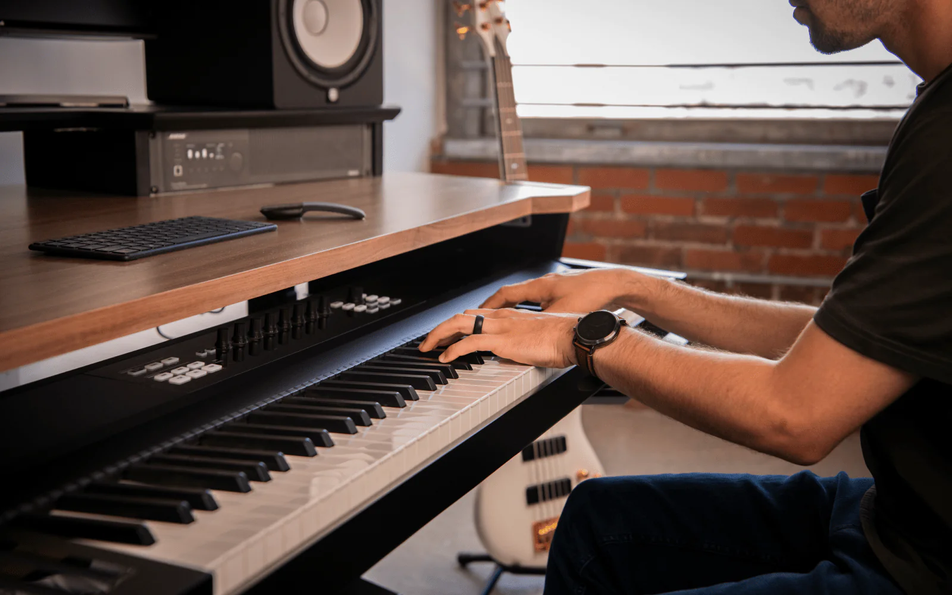Are you experiencing neck or back pain? If you answered "yes," it's likely due to spending long hours in your studio, hunched over your desk, and sitting for extended periods. If this sounds like you, it's time for a change. Don't overlook your physical well-being and the impact of these unhealthy habits on your body. Discomfort, pain, and long-term health issues don't have to be your new normal. This article discusses the significance of ergonomics, the importance of your health, and why you should consider giving priority to your posture. Neglecting this aspect can lead to a range of issues, from reduced creativity and productivity to declining health. Prioritizing ergonomics can greatly enhance your studio experience.
The Health Implications of Poor Ergonomic Studio Desks
When considering health hazards in a studio, you might not immediately think of ergonomics. However, several negative health effects may be affecting you.
Back and Neck Pain
Poorly designed workstations or chairs can lead to back and neck pain. At AZ Studio, we've made it our mission to lead in ergonomic workstations. Factors like desk height, keyboard placement, and functionality are crucial for addressing this issue.
Repetitive Strain Injuries

Musicians and producers are unfortunately at risk of repetitive strain injuries. These injuries can result from excessive mouse-clicking, keyboard typing, or instrument playing, and they have the potential to cause long-term damage.
Eye Strain
Extended periods of staring at screens or equipment with blue light can lead to eye strain. This discomfort can manifest as headaches, dry eyes, and even vision problems.
Fatigue and Reduced Productivity
Discomfort and pain can lead to reduced focus and productivity. When we're not feeling our best, it reflects in our workflow and output.
The Benefits of Ergonomic Workstations
Investing in an ergonomic workstation or studio furniture can significantly impact your well-being and productivity. Here's why it matters.
Improved Comfort

Ergonomic chairs and workstations are purposefully designed to provide proper support to your body and posture. They offer a range of adjustable features, including seat height, lumbar supports, armrests, and sit-stand desks, which allow you to customize your setup for maximum, personalized comfort tailored to your unique needs.
Reduced Strain
Ergonomically designed equipment promotes proper posture and reduces strain on your muscles and joints. By encouraging healthy ergonomics, this setup minimizes the risk of injuries that can result from prolonged periods of poor posture and repetitive movements.
Enhanced Focus
Comfortable and ergonomic workstations create an environment where you can stay focused on your creative tasks. This not only improves your overall efficiency but also boosts your productivity, ensuring you can tackle your projects with concentration and dedication.
Long-term Health
Prioritizing ergonomics isn't just about immediate comfort; it's also about safeguarding your long-term health. By using ergonomically designed equipment, you can help prevent the development of chronic health issues that are often associated with poor posture and continuous repetitive movements. This proactive approach to your well-being ensures a healthier, more productive future.
Key Features of Ergonomic Studio Furniture
When choosing ergonomic studio furniture, consider the following key features:
1. Adjustability
The flexibility of your studio furniture is crucial. Ensure your workstation offers adjustable features, such as a keyboard tray that can be customized to your preferred height, adjustable bridge height on the desktop, or the option for a sit-stand desk with maximum height adjustability. Your studio chair should also complement your workstation comfortably. Look for chairs with adjustable height and seek lumbar support for added comfort.
2. Monitor Placement
Proper monitor placement is essential to prevent neck strain. Your monitor screen(s) should be positioned at eye level, whether mounted to the wall or placed on your studio workstation.
3. Keyboard Tray
To reduce wrist strain, maintain a comfortable height for your piano keys by using an adjustable keyboard tray.
4. Laptop, Computer Keyboard, and Mouse
These items are typically situated on the desktop surface, above your keyboard, which can be tucked under the desk on a pullout keyboard shelf when not in use. To prevent strain, keep your wrists level and avoid arching them during use.
5. Workspace Layout
Organize your equipment and gear in a way that encourages a natural and efficient workflow. Your layout may vary based on your specific setup, so plan ahead before mounting and managing cables to maximize your workspace's efficiency.
Experience AZ Studio's Ergonomic Studio Desks

Our happy clients have been singing praises of our sit-stand workstations for years. We've received feedback from hundreds of customers, and they are thrilled with their decision to choose the sit-stand feature. When fatigue sets in after hours of sitting, they can effortlessly raise their workstation and continue their work while standing. It has proven to be one of the most valuable features for any studio, significantly upgrading artists' workflows and overall productivity.
The option to seamlessly switch between sitting and standing, along with the ability to adjust the desk's height to their precise comfort and ergonomic position, is a game-changer. Take a look at one of our top sellers, the Elite Sit Stand Studio Desk. Once you experience the convenience of a sit-stand studio desk, you'll likely never want to work any other way!
To get an idea of how the sit-stand feature works on our Elite Sit Stand Studio Desk, check out this video. Additionally, see how Kris Bradley's experience with the Elite Sit Stand Studio Desk has changed her workflow for the better.

